Al-Ind-Esk-A-Sea

Like the M/S Diamond Knot that sank in August 1947, the Al-Ind-Esk-A-Sea was an Alamosa Class type C1-M-AV1 vessel. Her overall length at the time she was built was 338.5 feet, her beam was listed at 50 feet, depth at 29 feet, and draft at 18 feet. Her gross tonnage was recorded as 3,805 lbs., and using her single screw she could reach 11 knots using 1,750 horsepower.
She was built under Maritime Commission contract by Leatham D. Smith Shipbuilding Co., in Sturgeon Bay, Wisconsin. Originally projected as the “Washtenaw”, she was launched as the “Coastal Guide” on May 13, 1945.
Upon delivery to the Maritime Commission on July 16, 1945, she was operated by the United Fruit Company and the Polaris Steamship Company Inc.

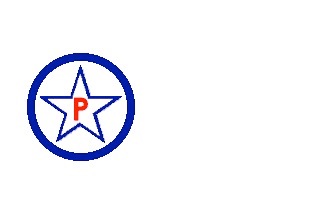
On June 23, 1948 the Coastal Guide was acquired by the US Army and renamed USAT Sgt. George Peterson, but on March 1, 1950 she was transferred to the US Navy and was listed as USNS Sgt. George Peterson.
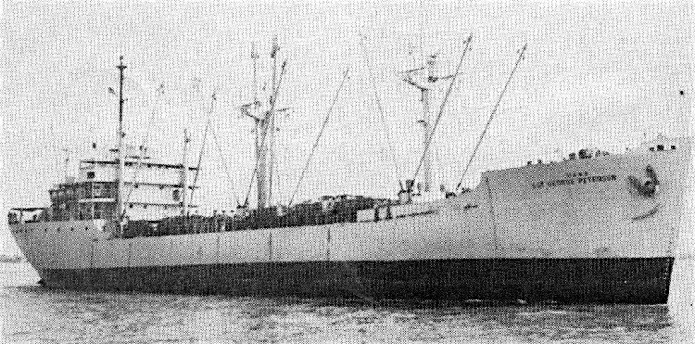
Following was eight years of operations in the Gulf of Mexico, in the Caribbean, and along the southeastern seaboard of the United States for the Military Sea Transportation Service. During that time, she interrupted her regular service only once to carry supplies north to arctic stations in the summer of 1955.
The Sgt. George Peterson was placed out of service in March 1959 in New Orleans, Louisiana and finally struck from the Naval Register in 1966. She was sold for non-transportation use in December 1971.
In 1979 the ship was sold for $250,000 to the TransAlaska Fisheries Corp., a subsidiary of the 13th Regional Corporation. The 13th Regional Corp. was created in 1971 under the Alaska Native Claims Settlement Act. The 13th Regional Corp., along with the 12 others, was created in settlement of native land claims. The Al-Ind-Esk-A Company is a company that, among other things, manages subsidiary companies under the 13th regional Corporation. One of those ventures was the Al-Ind-Esk-A-Sea. The name Al-Ind-Esk-A-Sea comes from: AL=Aleut (Aleutian Island Native) IND=Indian ESK=Eskimo A=Alaska SEA= Sea (Designation).
Under the TransAlaska Fisheries Corp. the Al-Ind-Esk-A-Sea was converted to a fish processing ship in Elliot Bay, Washington.


Senior Vice President of 13th Regional Corporation Crabs being processed aboard the Al-Ind-Esk-A-Sea;
Billy Blackjack Johnson at helm of Al-Ind-Esk-A-Sea; Courtesy University of Alaska Anchorage
Courtesy University of Alaska Anchorage

Crabs being loaded from other fishing boats to the Al-Ind-Esk-A-Sea, the mother ship. Courtesy University of Alaska Anchorage
On Tuesday, October 19th, 1982 the Al arrived in Everett Wasington, from Lake Union for “minor repairs”. It is not know the nature of the repairs, but John Bailey, the company’s general manager, stated the repairs had nothing to do with the refrigeration system.
On Wednesday October 20th, 1982 the Al was in the harbor in Port Gardner, waiting for moorage when the fire started. Reports state that the ship carried 15,000 pounds of liquid ammonia, several containers of chlorine, 1,500 gallons of lube oil, and 10,000 gallons of diesel fuel. Reports further state that there was some welding going on in the holds and through a bulkhead to install some drains when the fire started. Supervising the projects was a firewatch, normal protocol (although not required by law) when using flame around combustible material.
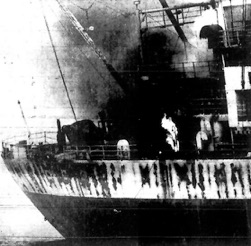
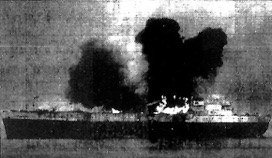
When the explosion occurred, crew-members were top-side securing the Alaska Trader (another fishing vessel that unloaded catch from the mother ship), so all cre-members were able to exit the burning ship.
The Al burned for three days, and with the fear of ammonia gas and cyanide fumes (from polyurethane insulation) entering the atmosphere, the fire department, as well as the Coast Guard, kept away from the toxic ship. Some of the ammonia containers caught flame and exploded sending fire 30 - 40 feet in the air. The fire let off so much white smoke that the Coast Guard kept other boats and aircraft away.
On the 21st, the Fire Department’s Alki arrived to fight the fire. By 8 pm the flames were knocked down on the main deck, but below deck the blaze was ignored because it was too dangerous to battle. The burning ammonia on board, stated the Dept. of Ecology, would be reduced to harmless nitrous oxide (laughing gas) but explosions could release toxic ammonia gas. Fortunately, the winds carried the toxic smoke away from downtown Everett.
Finally, on Friday October 22nd, 1982 at about 10:14 am, The Al-Ind-Esk-A-Sea rolled over on her starboard side, then went down stern first in 240 feet of water. She left behind a lone raft, about 60 barrels of oil, and a sheen of diesel fuel about two miles long, several hundred yards wide, and no more than a quarter inch thick, a “small” oil spill says Jerry Galt of NOAA.
The Al-Ind-Esk-A-Sea was insured for $14,000,000.
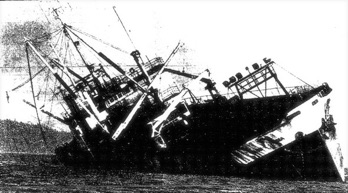
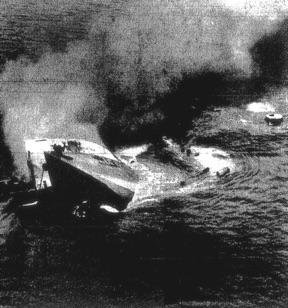
Courtesy of Joe McMillan
(Left) Stern of the Al on fire
(Bottom) Fire engulfing the Al
Courtesy Seattle PI
(Left Above) Al listing to starboard
(Right Above) Al’s bow before submerged
Courtesy Seattle PI
(below) Courtesy Everett Newspaper
Courtesy United fruit Historical Society

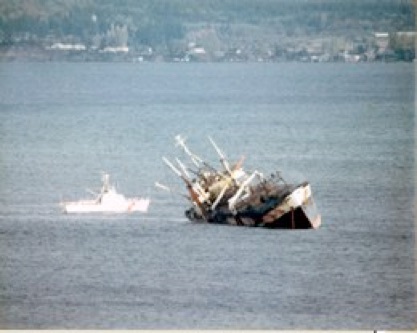
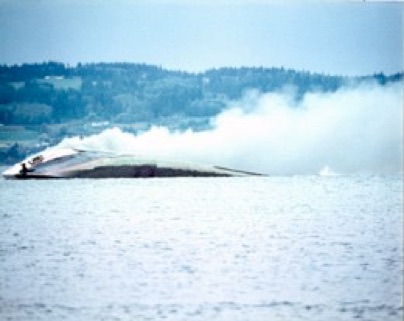


-
-Home
